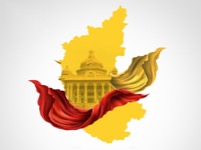Published on: November 3, 2022

Kannada Rajyotsava
Kannada Rajyotsava

Why in news?
Kannada rajyotsava is celebrated on November 1st every year.
Highlights:
- Propelled by the Karnataka Ekikarana movement and decades of protests, all Kannada-speaking regions outside the Mysore Princely State were unified into one State on November 1, 1956. However, the newly-banded State was named Mysore, and not Karnataka, the journey to which would take almost another decade-and-a-half.
- Even after the Karnataka Ekikarana movement, it continued to be called Mysore.
- During the Legislative Assembly debate between July 25 and 27, 1972, Devraj Urs put forth the proposal in the Legislature.
- The resolution was enacted by Parliament a year later on 21 August, 1973, through the Mysore State (Alteration of Name) Act, 1973
- Thus it was that 17 years after the unification, the Mysore State became Karnataka on November 1, 1973. Today marks 50 years since that historic decision.
What is the Origins of the word ‘Karnataka’?
- Even before the Karnataka Ekikarana movement gained steam towards the end of the 19th century, the words ‘Karṇaata’, ‘Karnataka’ and ‘Kannada’ had been used on several occasionsby poets, writers, and historians to address this region.
- Most definitively, the word ‘Karnataka’ finds a place in the second line of Kuvempu’s Jai Bharata Jananiya Tanujaate, written in 1924 and adopted as the State anthem in 2004.
- The oldest known mention, however, is found in the Sanskrit Mahabharata, dating back to approximately the 6th century BC according to researcher
- The word Karṇaataah is used to refer to the place from where a battalion of soldiers had come to fight the Kurukshetra war,” is an another theory
- There are also geographical bases to the etymology. “In Tamil, ‘karu’ means mountain and ‘naatu’ means a village or town. The Deccan plateau is at an elevation compared to Tamil Nadu. Thus, the word ‘Karnaata’ could have meant an ‘elevated land or higher ground’,”
- Furthermore, in the 1930s, scholar Sham. Ba. Joshi traced Karnataka to Kannaru, a community of pastoralists that existed in this region.
- Another popular theory, espoused by German linguist Hermann Gundert, says the name comes from ‘Kari (or Karu) Naadu’, an allusion to the black soil found in the State, crucial for cotton cultivation.
- Interestingly, Kari also means elephant and could point to the fact that the region was once home to many elephants.
- In the 15th century, poet Kumara Vyasa wrote Karṇaata Bharata Kathamanjari, the first Kannada rendering of the Mahabharata. Till colonial powers took over, the land was mostly known as Karṇaata
- However, historians argue that the Vijayanagara Empire, founded in 1336, has been called as ‘Karnataka Desha’ in some inscriptions.
Though the etymology of ‘Karnataka’ can be traced to multiple texts and theories, researchers agree that each of them encompasses the history, the culture, the language, the people, the geography, and the way of life of the land.

